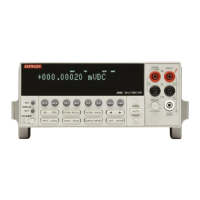Calibration
2-25
prehensive commands, or Table 2-8 for low-level com-
mands.) Remember that you must unlock calibration first.
Before sending any calibration commands, you must send
the ":CAL:PROT:INIT" command to intialize calibration.
After calibrating the desired point(s), you must then save the
new calibration constants by sending the
":CAL:PROT:SAVE" command over the bus. You can then
lock out calibration by sending ":CAL:PROT:LOCK".
Example
As an example, assume that you intend to calibrate the 2kΩ
range. The basic steps are summarized below:
1. Turn on the Model 2002 power, and allow the instru-
ment to warm up for at least four hours before perform-
ing calibration.
2. Press the front panel CAL switch to unlock calibration.
3. Send the following command over the bus to initiate
calibration:
:CAL:PROT:INIT
4. Connect the 2kΩ (or closest available value) calibration
source to the front panel INPUT and SENSE jacks using
the 4-wire connections shown in Figure 2-1.
5. Send the following calibration command over the bus:
:CAL:PROT:DC:OHM2K 2E3
Be sure to substitute the exact calibration resistance value for
the 2E3 parameter in the above command. For example, if
the resistance value is 1.90034kΩ, the command would
appear as follows:
:CAL:PROT:DC:OHM2K 1.90034E3
6. Repeat steps 4 and 5 as desired for other calibration
points.
7. If desired, send the following commands to program the
calibration date and calibration due date:
:CAL:PROT:DATE <yr>,<mon>,<day>
:CAL:PROT:NDUE <yr>,<mon>,<day>
8. Send the following command to save calibration
constants:
:CAL:PROT:SAVE
9. Finally, send the following command to lock out
calibration:
:CAL:PROT:LOCK

